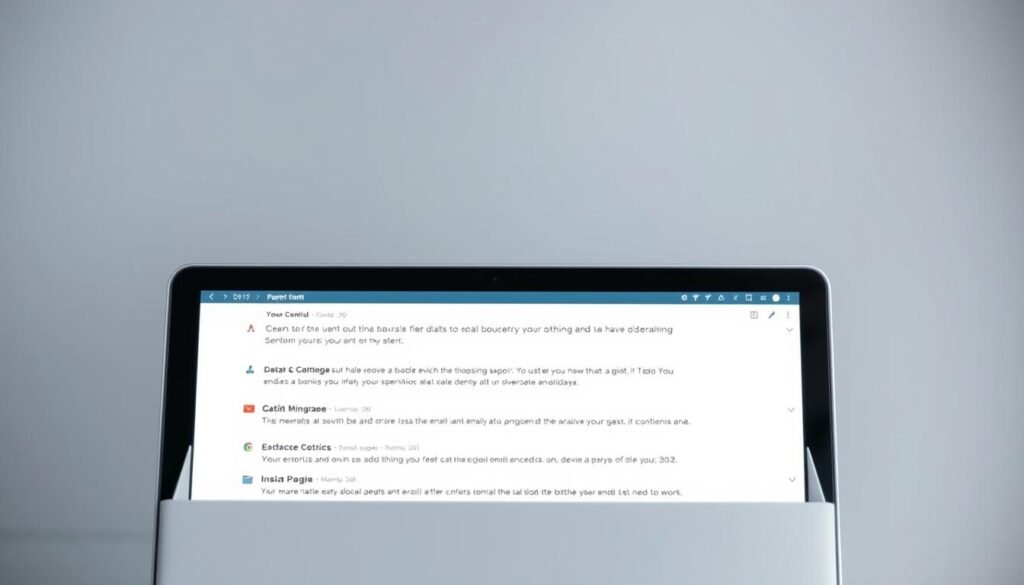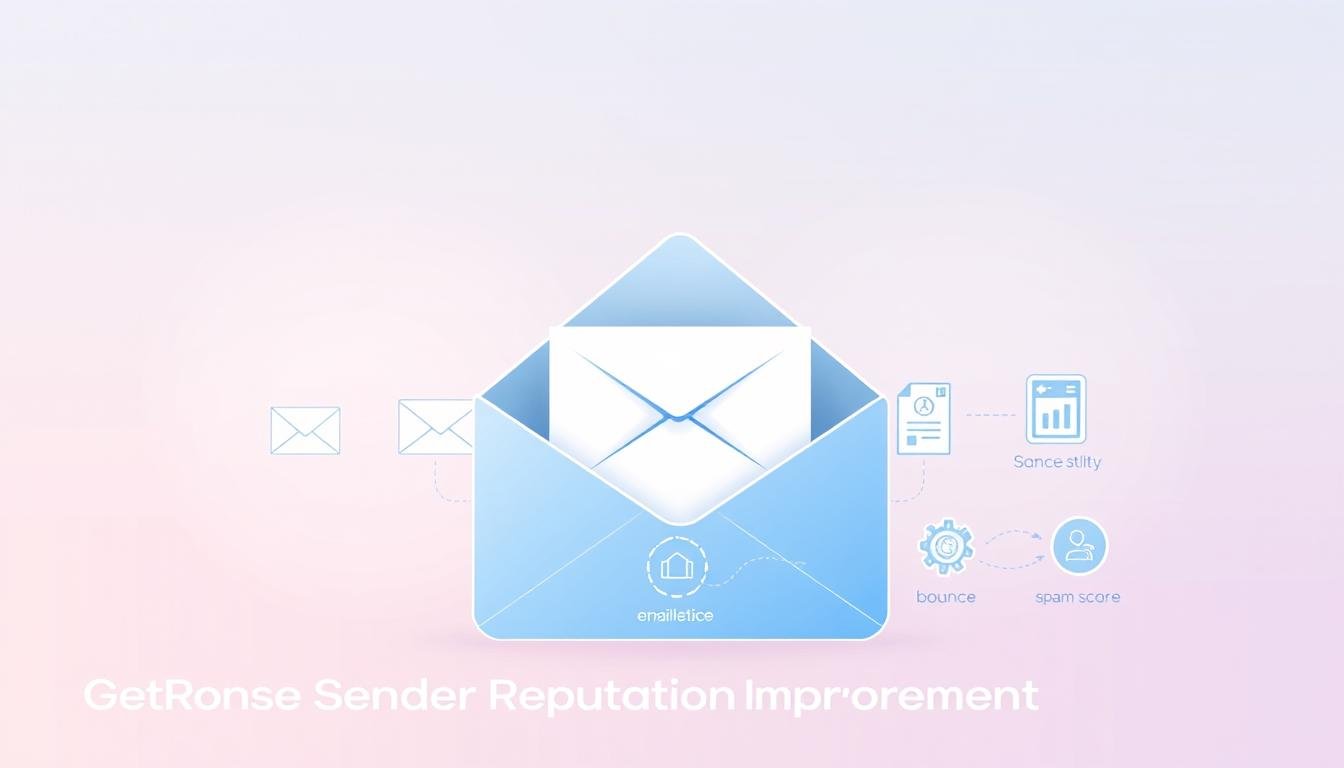Improve inbox placement by understanding how mailbox providers score your sending. Mailbox providers assign a numerical score that affects whether your email lands in the inbox or the spam folder.
Recent shifts matter: Gmail and Yahoo tightened filters in 2022 and now require stronger authentication. DKIM and DMARC rules for bulk senders take effect in February 2024, so authentication is non-negotiable for healthy deliverability.
You’ll see a practical framework here: diagnose issues, apply authentication, clean and segment your list, and warm up IPs and domains. Assisted IP warmup has shown real gains — one program drove a 4x open-rate lift after four weeks versus standard warmup.
Benchmarks help you set goals: average opens around 39.6%, CTR about 3.25%, and spam complaints under 0.01%. Use these thresholds to prioritize fixes and measure progress.
Key Takeaways
- Authenticate domains with DKIM and DMARC to meet provider rules.
- Clean and segment your list to reduce bounces and complaints.
- Warm up IPs/domains gradually; assisted warmup can accelerate results.
- Monitor metrics (opens, CTR, bounces, spam) against benchmarks.
- Use tools like Google Postmaster and MxToolbox to track health.
Why sender reputation and deliverability matter right now
Starting in 2024, authentication rules from major providers force marketers to rethink how their messages reach users. Gmail and Yahoo now require DKIM and DMARC on a custom sending domain for bulk email. This shift raises the bar for inbox access and makes email authentication table stakes.
Gmail and Yahoo’s 2024 authentication changes and what they mean
Unauthenticated or weakly authenticated emails face tighter filtering. Providers treat higher-risk traffic more aggressively, which can push even “delivered” mail into the spam folder or secondary tabs.
How poor deliverability kills campaign ROI even when “delivered”
Deliverability differs from delivery: many messages marked delivered never reach the primary inbox. A 15-tool study found average deliverability at 83.1%. Aim for ≥95% to secure visibility and conversion.
- Unauthenticated sends increase filtering and throttle rates.
- Poor engagement and complaints degrade sender reputation and long-term inbox access.
- Bulk volumes amplify costs of low deliverability across marketing campaigns.
Treat deliverability as a performance lever: fix authentication, monitor engagement, and prioritize inbox placement to protect campaign ROI. Tools like GetResponse offer automatic setup and monitoring to help you comply and focus on content and testing.
Sender, domain, and IP reputation: what’s the difference?
Understanding how domain and IP signals work together helps you protect inbox access.
Domain reputation is tied to your brand and reflects how recipients interact with your emails over time. It follows your domain across infrastructure changes and rewards consistent engagement.
By contrast, IP reputation is linked to the mail server and can swing with volume, list quality, or neighbor behavior on shared infrastructure. An email service provider or mailbox provider weighs both signals when scoring mail.
Shared vs. dedicated IP implications
Shared IPs suit smaller senders: they provide steady throughput but expose you to community behavior. Dedicated IPs let high-volume senders build a clean path, but they demand disciplined warmup and steady cadence.
- Strong domain reputation can cushion minor IP issues but won’t fix chronic server problems.
- Use tools like Google Postmaster and blocklist monitors to track health.
- If lists grow fast, tighten hygiene to protect deliverability and long-term reputation.
Coordinate authentication, content quality, and IP strategy to sustain inbox placement and support your marketing goals.
Diagnose first: a quick deliverability health check
Start with a focused audit so you fix the root causes of poor inbox performance. Run a quick technical and engagement review before changing cadence or creative.
Verify authentication and alignment
Confirm SPF, DKIM, and DMARC exist, are valid, and align with your From domain. Gmail and Yahoo require DKIM and DMARC for bulk senders in 2024, so alignment is mandatory.
Monitor delivery signals and blocklists
Use Google Postmaster Tools to watch domain-level metrics and complaint rates. Check Sender Score for overall scoring and MxToolbox for blacklist lookups and DNS misconfigurations.
Benchmark engagement and rates
Compare the last 30–90 days to these targets: opens 39.64%, CTR 3.25%, CTO 8.62%, bounces 2.33%, unsubscribes 0.15%, and spam complaints
| Check | Tool | Action |
|---|---|---|
| Authentication & alignment | DKIM/SPF/DMARC DNS & validators | Validate records and align with From address |
| Domain and IP health | Google Postmaster / Sender Score | Monitor drops and investigate provider-specific issues |
| Blacklist & DNS issues | MxToolbox | Remediate listings and fix DNS misconfigs |
| Inbox placement | Seed tests / platform analytics | Measure true inbox reach by provider |
- Segment complaint and bounce drivers by campaign to find fixable patterns.
- Audit signup sources and consent records to lower downstream spam rates.
- Document findings and run weekly re-checks while you remediate.
GetResponse sender reputation improvement
Scale safely by using automated warmup and platform-level protections that limit sudden volume spikes.
Assisted IP Warmup lets you ramp sends as engagement proves healthy. The service sets initial thresholds and increases them automatically as positive signals accrue. In tests, assisted warmup produced over 4x the opens after four weeks versus standard warmup for high-volume accounts.
Leverage Assisted IP Warmup and dedicated IP options
Deploy assisted warmup to scale volume without abrupt jumps on your dedicated path. If you run large, steady campaigns, a dedicated IP gives full control over the reputation curve.
When spikes are necessary, overflow to shared IPs avoids sudden volume surges on your dedicated IP and preserves deliverability.
Use built-in spam checks, compliance, and monitoring
Use the platform’s spam checks to catch risky subject lines and content before sending. Automatic handling of bounces, unsubscribes, and complaints keeps files clean and lowers spam rates.
- Monitor domain and IP health regularly; compliance teams watch blocklists and bounce reasons.
- Authenticate with DKIM and DMARC to meet modern provider rules and protect inbox placement.
- Favor engaged segments during warmup to accelerate trust signals and lift opens.
For more detail on how this service stacks up, read a deliverability comparison with other platforms here.
Set up rock-solid authentication to pass modern filters
Strong authentication is the foundation that lets your messages reach real inboxes. Gmail and Yahoo now require DKIM and DMARC for bulk senders, so use a custom sending domain—not freemail—when you send at scale.
SPF, DKIM, DMARC: configuration basics and required policies
Publish SPF records that include your sending platforms and remove obsolete hosts to avoid soft fails.
Enable DKIM signing so mailbox providers can verify message integrity with cryptographic signatures tied to your domain.
Implement DMARC with an aligned From domain. Start at p=none to collect reports, then move to quarantine or reject as you resolve unauthorized sources.
- Use DMARC RUA/RUF reports to find shadow IT and misconfigured services.
- Audit subdomains for marketing vs. transactional streams and set clear DNS policies.
- Periodically test records with MxToolbox and Postmaster Tools after changes.
BIMI and brand consistency to boost trust and engagement
After DMARC enforcement, adopt BIMI to show your logo in supporting inboxes. Standardize From name and address across campaigns to strengthen brand signals and lift deliverability and opens.
Keep your email list clean to avoid bounces and spam traps

A proactive hygiene routine stops traps before they damage your sending path. Clean email files protect deliverability and limit the risk of immediate IP or domain blocking from spam traps.
Spam traps come in three common forms: pristine honey pots, recycled addresses, and typo traps. Hitting any of these can trigger long-term consequences for your email programs.
Verification, validation, and ongoing cadence
Validate new addresses with a verification tool before import, especially when lists grow fast or you target B2B contacts with job churn.
Set a hygiene cadence: suppress hard bounces immediately and watch soft bounces by domain patterns. The average bounce rate benchmark is about 2.33%; keep yours below that to stay healthy.
Handling bounces, role accounts, and traps
Remove hard bounces permanently. Treat soft bounces as temporary but investigate recurring issues.
Filter role accounts (info@, sales@) and obvious typos. Monitor inactivity, reengage subscribers, then drop non-responders to reduce trap exposure.
- Track acquisition sources to find high-risk channels and stop using them.
- Use tagging and a simple engagement score to auto-suppress low-activity people.
- Never buy lists; they bring traps and legal risk under CAN-SPAM and GDPR.
| Action | Tool | Frequency | Why it matters |
|---|---|---|---|
| Address verification on import | Email verification API | Every import | Blocks typos and honeypots before they join lists |
| Suppress hard bounces | Platform bounce handling | Immediate | Prevents repeated delivery to invalid addresses |
| Soft bounce analysis | Delivery reports by domain | Weekly | Detects provider-level issues and transient blocks |
| Inactivity reengagement | Segmentation & scoring | 90 days | Removes non-responders and lowers spam trap risk |
Keep consent records and transparent acquisition logs. These defend your program if mailbox providers or regulators question your emails.
Build engagement signals with content and sending practices
Strong engagement starts with content that matches what your audience expects and needs. Engagement rates drive how mailbox providers score your domain and affect deliverability and long-term reputation.
Segmenting, personalization, and value-driven content
Segment by lifecycle, behavior, and intent so your message reaches the right people at the right time. Use preference data and purchase or browsing history to tailor content blocks and dynamic CTAs.
Send value-first emails that solve problems. Low-value blasts lower opens and harm deliverability. Track cohort rates by acquisition source to prioritize high-performing groups.
A/B testing subject lines, CTAs, and offers to lift rates
Test one variable at a time—subject, CTA, or offer—and run continuous experiments. Measure opens (benchmark 39.64%), CTR (3.25%), and CTO (8.62%) to see real gains.
- Use click maps and site analytics to identify content that converts.
- Optimize preheaders and preview text to boost early engagement.
- Keep design, tone, and From identity consistent to reinforce brand signals.
Follow these best practices and your campaigns will send more relevant emails that subscribers open and act on, improving deliverability and sender reputation over time.
Control frequency, set expectations, and reduce list churn
Set expectations at signup so new subscribers know the types of email they will get and how often. Clear promises reduce surprise and lower complaint rates.
Preference centers let contacts choose topics and cadence. When users pick what they want, lists stay cleaner and engagement holds steady.
Preference centers and opt-downs vs. opt-outs
Offer a preference center that lets people select frequency and topics. This simple control cuts opt-outs and preserves relationships.
- Include an opt-down on the unsubscribe link page so subscribers can reduce frequency instead of leaving.
- Watch engagement decay by frequency segment to spot over-mailing or under-mailing.
- Pause or slow cadence for low-engagement cohorts to avoid spam signals and protect deliverability.
- Use send-time optimization and throttling during peak seasons to maintain stable inbox performance.
- Tie frequency rules to lifecycle stages—new subscribers need onboarding drips; mature segments want fewer emails.
Communicate major cadence changes in advance and keep subscription management mobile-friendly. These practices keep lists healthier and protect your domain and sending path over the long way.
Minimize complaints: transparent opt-in and easy unsubscribe

Transparent consent and simple exits cut complaint rates and protect deliverability. Average spam complaint rates were below 0.01% in 2024 benchmarks, so even small improvements matter.
Single vs. double opt-in: quality or scale?
Single opt-in grows lists fast but invites typos and low-quality email addresses. Double opt-in typically yields ~30% fewer signups yet reduces bots, traps, and bad addresses.
Choose double opt-in when you face deliverability issues or suspect bot signups. Accept the volume trade-off for cleaner, more engaged email lists.
- Make opt-in language explicit about content and cadence to avoid surprises that make people mark emails as spam.
- Add list-unsubscribe headers and a clear unsubscribe link so users can leave without frustration.
- Validate email addresses on capture to avoid typos and future bounces or traps.
- Capture consent source and timestamp to prove compliance and defend your program.
- Avoid pre-checked boxes or dark patterns; deceptive UX drives complaints and harms reputation.
Remind subscribers why they joined and measure complaint rates by acquisition source. These best practices keep delivery steady and protect your domain and reputation.
Warm up new domains and IPs the right way
Warmup is a deliberate, data-driven ramp that earns inbox trust one segment at a time.
Start by sending emails to your most engaged users. These recipients open and click more, which signals quality to mailbox providers. Begin with small batches and only increase volume after you see stable open and click rates.
Start with engaged segments and increase volume gradually
Begin with your top-engagement cohort. That means recent openers, recent buyers, and people who clicked in the last 30–90 days. Ramp daily volumes methodically and avoid sudden spikes that can trigger throttling or blocks.
Consistency, patience, and monitoring during warmup
Keep cadence, content type, and From identity steady. Change too many variables at once and you muddy the signals ISPs use to assess quality.
Monitor bounces, complaint rates, and blocklists every day. Pause and fix root causes before you raise volumes again.
When to choose assisted warmup for faster, stable inboxing
Use an assisted warmup tool if you need a predictable, automated ramp. It sets thresholds, routes overflow to shared infrastructure, and enforces safe increases so you can scale without guesswork.
| Step | Action | Why it matters |
|---|---|---|
| Begin with engaged segment | Send to recent openers and clickers | Produces strong early signals to ISPs |
| Increase volume methodically | Raise sends by set percent each day | Avoids sudden spikes and throttling |
| Monitor and pause | Track bounces, complaints, and lists daily | Fix issues before scaling further |
| Use assisted ramp tools | Automate thresholds and overflow | Faster stable inboxing with less manual work |
- Avoid heavy images, link shorteners, and spammy phrases while volumes are fragile.
- Warm up domains too: validate DNS, DKIM, and DMARC before sending at scale.
- Document thresholds tied to open and bounce rates; plan parallel ramps if migrating platforms.
Spot, fix, and avoid deny/blacklists
Detect listings fast. Use monitoring tools and routine checks so a block doesn’t cripple your campaigns.
How to identify listings and request delisting
Check major deny lists such as Spamhaus, BRBL (Barracuda Reputation Block List), and SpamCop with MxToolbox. Add alerts so you learn about new entries immediately.
If you find a listing, gather delivery logs, bounce reports, and evidence of consent. Then contact the list operator with a clear remediation summary and steps you took.
Process changes that prevent relisting
Fix root causes, not symptoms. Audit recent imports and acquisition sources for spam traps and bad addresses. Remove risky segments and tighten sign-up validation.
- Suppress hard bounces and sunset long-term inactives.
- Improve opt-in clarity and simplify unsubscribe paths to cut complaints.
- Validate authentication and alignment; misconfigs can look suspicious to a service provider.
- Avoid sending campaigns to unverified new lists; ramp cautiously.
| Action | Tool | Follow-up |
|---|---|---|
| Monitor blacklist status | MxToolbox | Set alerts and weekly reviews |
| Check domain health | Sender Score | Track post-delisting metrics |
| Audit lists for traps | Email verification | Remove flagged addresses and fix forms |
Log every corrective action and keep the team aligned on standards. Continuous monitoring prevents relisting and protects long-term deliverability and reputation.
Conclusion
Strong inbox performance comes from disciplined setup and everyday list care, not quick fixes.
To protect your email marketing, authenticate domains (DKIM/DMARC), keep lists clean, and build steady engagement. Use assisted IP warmup or a dedicated path when volumes grow.
Monitor domain health with Google Postmaster Tools, Sender Score, and MxToolbox. Watch benchmarks: spam complaints <0.01%, bounces ~2.33%, unsubscribes ~0.15%.
Follow best practices for content, cadence, and consent so your messages reach people who want them. Institutionalize these practices across teams and you’ll convert delivery work into sustained ROI for your marketing campaigns and email programs.

